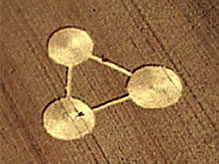Article/Document:
Brief Summary of CSETI Research Results
Steven M. Greer MD, Director, CSETI
original source | fair use notice
Summary: Summaries of 4 major CE-5 expeditions by CSETI in 1992-93. From Mexico, Florida, England and Belgium.
A. Mexico January 30, 1993:
On January 30, 1993, the RMIT was activated and sent to the volcanic zone outside of Mexico City, Mexico. Just before 12:30 a.m., local time, on January 31, 1993, while engaging in CSETI protocols to vector extraterrestrial spacecraft into the site, the entire team was briefly engulfed in a beam of amber light, which originated in the northwest sky. No conventional source for this beam was found. Later, on February 1, 1993, the team was able to vector into the site a large triangular craft, measuring 300-800 feet in diameter (one to three football fields). This craft responded to the team's signals, circled the area, and descended with its leading edge fully illuminated in what appeared to be a landing attempt. This triangular craft was approximately 300 feet in elevation and under 5000 feet from the research site. It had a brilliant light at each corner of the triangle, and a red pulsating light in the center. It was accompanied by a small red-orange probe or scout craft. As the craft left the areas, it repeatedly returned signals from the team, and then dipped below a ridge and was not seen again that night. This contact lasted about ten minutes. On February 2, 1993, the same type craft returned, this time under 200 feet, and again signaled in an interactive manner with the team. During the last 24 hours the team was in Mexico, it encountered during daylight hours brilliant, shiny metallic discs which hovered or flew near the team members. Four such discs on four separate occasions were encountered by the team on February 3 and 4, 1993.
B. England July 27, 1992
At approximately 12:20 a.m. on July 27, 1992, on an 1800 acre farm near Alton Barnes, Wiltshire, England, the CSETI RMIT was successful in vectoring into the site a large, brilliantly lit, disc-shaped, domed craft, measuring 80-150 feet in diameter. This craft was silent, and less than 400 yards away, and came to within 10-30 feet of the ground. It was, in fact, in the same wheat field in which the RMIT was located. This craft signaled repeatedly to the group of four researchers, and a small amber object at one point detached from the object and went up into the clouds. While at close proximity, this craft caused magnetic disturbances to the compass so that the needle rotated counterclockwise 360 degrees around the compass dial. This near-landing event concluded with the craft receding into the mist and out of visible range after 10-15 minutes of signaling with the team.
C. Florida March 14, 1992:
On March 14, 1992, at 8:24 p.m., CST, on a beach near Pensacola, Florida, over 40 people present for a CSETI research team training exercise, were able to vector into the area four silent, hovering craft, which signaled repeatedly to the group, and changed formation in response to the group's light signaling. This event was observed from six locations, and videotapes and photographic evidence were obtained. These objects were under intelligent control and moved towards the group while exchanging light signaling with the team. This event lasted for 10-15 minutes.
D. Belgium February 5, 1992:
Having learned of a significant UFO wave in Belgium, the CSETI RMIT, consisting of four people, departed for Brussels on February 5, 1992. On the night of Februry 9- 10, the team conducted research under unfavorable weather conditions near the town of Eupan, Belgium. At 12:30 a.m. on the 10th the team saw at low elevation four objects approximately 300 feet away, brightly lit, which vanished suddenly after about five minutes of observation. The team returned the next morning to the site, and no explanation for the objects was found.
On the night of February 10, 1992, the team proceeded to a high ridge near Henri-Chapelle, and at 12:45 a.m. on the 11th successfully vectored into the site a large triangular, silent craft which dipped below the low cloud cover to reveal a brilliantly lit apex of the triangle. The light on this part of the craft was about the size of a full moon. A few minutes later the team heard a low vibratory rumbling directly above them, which seemed to be turned on and off in rapid succession twice. This vibration was above the team in the clouds and was stationary.
Read more articles on this topic:







